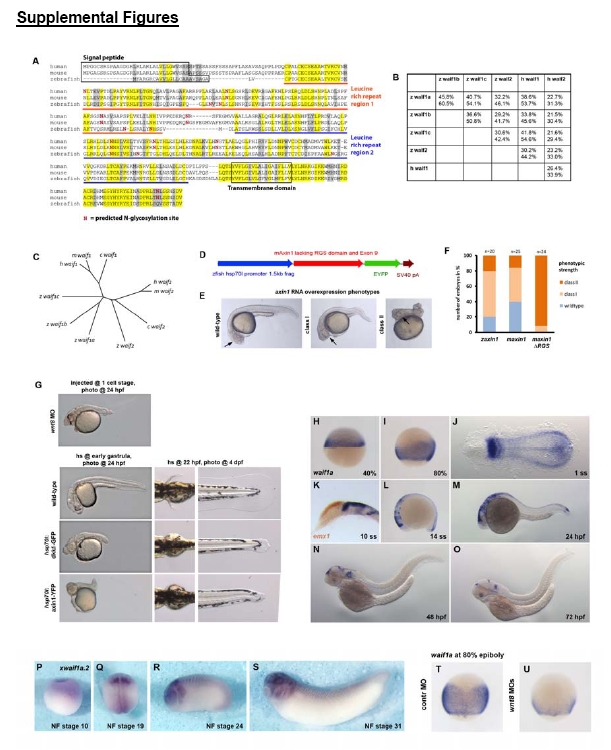Fig. S1
Waif phylogeny and expression during zebrafish and Xenopus embryogenesis and creation of a transgenic zebrafish line expressing Axin1-YFP after heatshock. Data characterizing a newly created hs:axin1YFP transgenic fish line are presented, as well as, the primary sequence conservation of waif family members, the phylogenetic relationship of zebrafish and mammalian Waif proteins, the expression pattern of zebrafish waif1a and Xenopus waif1a.2 in wildtype embryos and data showing that waif1a expression is regulated by wnt8 in zebrafish embryos.
Waif phylogeny and expression during zebrafish and Xenopus embryogenesis and creation of a transgenic zebrafish line expressing Axin1-YFP after heat-shock, related to figure 1
(A-C) Waif1a is part of a family of proteins of which zebrafish contain four members and humans two.
(A) Multiple sequence alignment of human and mouse Waif1 (Trophoblast glycoprotein / 5T4) with zebrafish Waif1a. Identical amino acids are highlighted in yellow, conservative exchanges are in grey. The predicted signal sequence, leucine rich repeat regions, the predicted transmembrane domain and presumptive N-glycosylation sites are indicated.
(B) Percentage of identical and similar (second number in each field) amino acids between the zebrafish and human proteins are shown.
(C) Phylogenetic relationship of human, mouse, and zebrafish Waif proteins. An unrooted phylogenetic tree was created using the Neighbor-joining method. Accession numbers of proteins used: h waif1= Human 5T4 NP_006661, m waif1= mouse 5T4 NP_035757, zwaif1a= NM_194392, z waif1b = XM_001338403, z waif1c = XP_001332297, z waif2 = XP_001337909, h waif2 = XP_497310, m waif2 = XP_486328.
(D) Cartoon of the construct used to create the hsp70l:Axin1-YFP transgenic zebrafish line.
Mouse Axin1 lacking the N-terminal RGS domain fused to EYFP at its C-terminus was cloned downstream of the zebrafish heat-shock protein 70-4 promoter.
(E-G) Overexpression of Dkk1-GFP and Axin1-YFP recapitulates knockdown of wnt8 expression.
(E) Classification of phenotypes at 24 hpf produced by axin1 RNA overexpression. Class I displays enlarged anterior neural structures including eyes (arrow) and reduced trunk and tail. Class II in addition shows signs of dorsalization (snailhouse-like tails).
(F) Full-length zebrafish axin1, full-length mouse axin1 and mouse axin1 lacking the RGS domain produce similar phenotypes, but with different penetrance.
(G) Comparison of phenotypes produced by knockdown of wnt8 (2 + 2 ng of wnt8 ORF 1 and wnt8 ORF 2 MO each) and by activating the heat shock inducible Dkk1-GFP and Axin1-YFP transgenes at early gastrula (50% epiboly) and organogenesis (22 hpf) stages. All embryos were heat-shocked for 1h at the stages indicated. Note that Axin-YFP overexpression phenocopies Dkk1-GFP, deleting posterior structures and increasing eye and forebrain size when activated during gastrulation, and inhibiting pectoral fin development when activated during organogenesis. Note also the very similar phenotypes produced by Dkk1-GFP or Axin1-YFP activation during gastrulation and that produced by Wnt8 MOs.
(H-O) Zebrafish waif1a expression pattern determined by whole mount in situ hybridization at the indicated stages. ss = somite stage (K) Double staining with emx1, which marks the dorsal telencephalon, shows that the strongest waif1a expression in the CNS during somitogenesis is found in the forebrain-midbrain boundary and dorsal midbrain.
(P-S) Expression pattern of Xenopus laevis waif1a.2 at the indicated stages. NF =Nieuwkoop and Faber.
(T-U) Zebrafish waif1a expression is regulated by wnt8 during gastrulation. Dorsal views of embryos injected with 8 ng standard control morpholino or 4 ng each of wnt8 ORF 1 and wnt8 ORF 2 morpholinos are shown at 80% epiboly. 19/19 wnt8 morphant embryos showed severe downregulation of waif1a expression.
Reprinted from Developmental Cell, 21(6), Kagermeier-Schenk, B., Wehner, D., Ozhan-Kizil, G., Yamamoto, H., Li, J., Kirchner, K., Hoffmann, C., Stern, P., Kikuchi, A., Schambony, A., and Weidinger, G., Waif1/5T4 Inhibits Wnt/β-Catenin Signaling and Activates Noncanonical Wnt Pathways by Modifying LRP6 Subcellular Localization, 1129-43, Copyright (2011) with permission from Elsevier. Full text @ Dev. Cell

